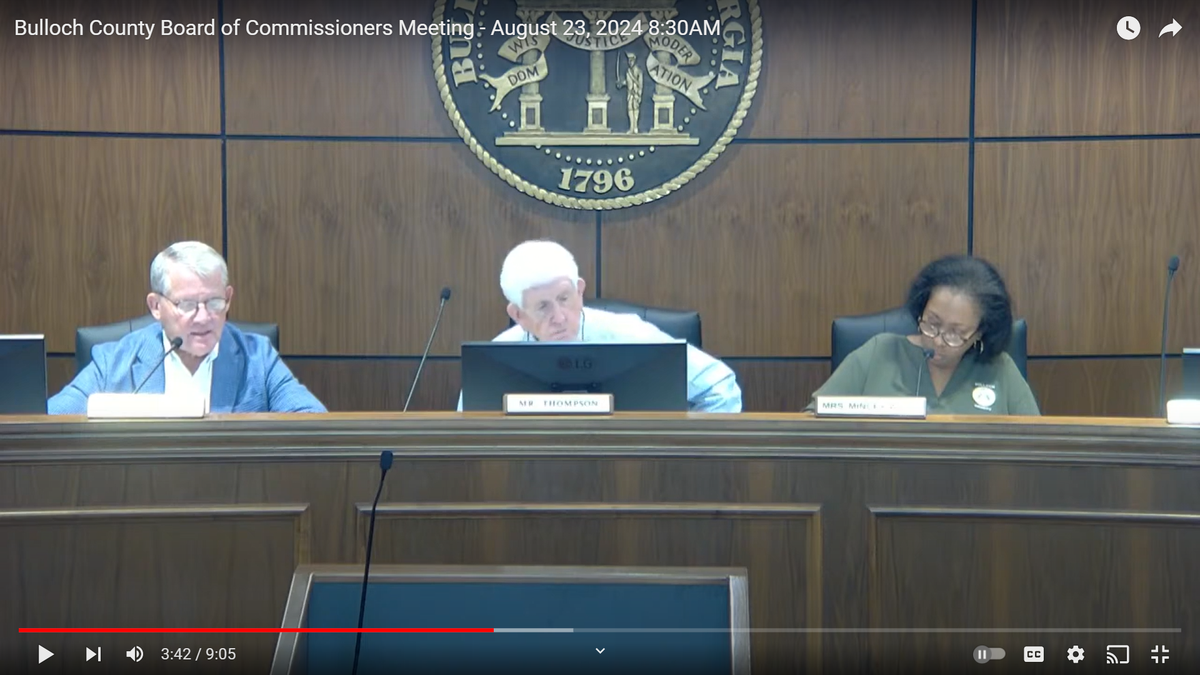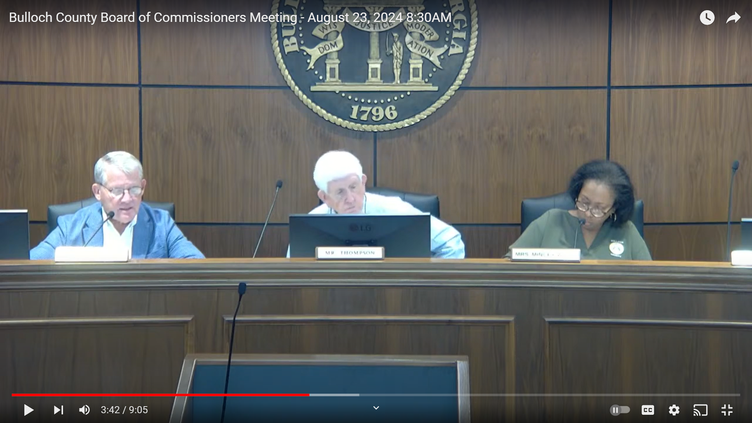Since the Bulloch County commissioners rolled back the property tax millage rate for county government operations by more than the amount required to offset inflation in assessed property values, they didn’t have to declare a tax increase or hold tax increase hearings.
But the Board of Education, meanwhile, held a series of three tax increase hearings and adopted only a partial rollback of its millage rate, not completely offsetting the revenue gain from inflation. After holding its third such hearing at 9 a.m. Thursday, Aug. 22, the school board during its regular 6:30 p.m. regular “work session” meeting adopted its previously advertised rate of 7.932 mills, down from 8.478 mills last year and now the lowest rate in more than a decade. But this was still considered a 4.95% tax increase in comparison to the 7.558-mill “rollback rate” required to avoid the hearings.
Holding a special meeting at 8:30 a.m. Friday, the Board of Commissioners then formally adopted the school board rate along with their own 2024 tax rate for the county government general fund, 11.35 mills. This represents a 1.5-mill, or 11.7%, reduction from last year’s county rate of 12.85 mills.
For this portion of the millage, the “statutory” rollback rate – determined by the county tax assessors as the reduction needed to offset inflation – would have been 11.46 mills. So the 11.35-mill rate the Board of Commissioners staff proposed, and the commissioners adopted, was 0.11 mill less than required to avoid tax increase hearings.
“It was possible because there has been a lot of real growth in the county, not just inflationary growth, so we were able to roll back, and we’ll be getting only about 1 percent more in revenue than we did the prior year,” county Chief Financial Officer Kristie King said in a phone interview.
Real growth
A 1.3% projected increase from 2023 to 2024 in property tax revenue was shown in the county government’s recently advertised “five-year history of levy.” The chart included the digest value of taxable property in Bulloch County and a history of the Board of Commissioners’ millage rates and estimated revenue for 2019 through 2024. As King explained, this 1.3% increase reflects real growth in the digest, such as from construction and improvements to homes and businesses.
Local governing boards are not required to roll back tax rates to compensate for real growth. But under the Georgia law known as the Property Taxpayer’s Bill of Rights, they must either roll back their millage rates to compensate for the average inflation in the value of existing property or announce a tax increase and hold the hearings.
Based on the net digest values, the real growth amounted to nearly 4%, but the commissioners’ millage rate gave up a portion of this by reducing the millage by more than the 10.8% required to offset inflation.
“Some of that was due to other revenues that were coming in higher, so even though we increased the budget, we didn’t feel like we needed to increase the tax revenue as much,” King said.
Examples of other revenue sources for the county’s general fund include the Title Ad Valorem Tax on vehicles at time of purchase and the Hospital Authority of Bulloch County’s contribution to the county from investment earnings. That amount was higher last year than expected and may again be higher than in earlier years, King said.
Last year’s increase
Last year, the commissioners approved a 1.5-mill rate increase on top of a large average inflationary rise in assessed property values. The resulting overall 28% tax hike has drawn criticism from some county residents ever since, including an organized group called the Bulloch Action Coalition, and clearly played a role in the defeat of three incumbent commissioners.
But Couch says that the explanation for last year’s increase has been overlooked and that the hike positioned the county for future rollbacks when real growth in the tax base results in increased revenue. Factors in the background to this strategy included the arrival of Hyundai Motor Group’s electric vehicle Metaplant America in the region, the placement of several of its supplier industries in Bulloch County, and a boom in residential subdivision plans.
Level of service
“We had to get our revenue level through the ad valorem (property) tax up to a point, to me a minimum level of service, for our population,” Couch said in an interview Friday. “We’d always to been running behind, and the commissioners decided this is where we needed to be to get up to the break-even point. …
“Also embedded in that message was that we believed that, even though some of the growth in the digest would be subject to inflation, we could rely on the future organic or natural growth in the digest coming from the Hyundai impact, and that’s going to give us the opportunity to give what we call the statutory rollback, and hopefully consecutively, in the future,” he said.
So as the digest value grows “maybe our effective tax rate can continue to decline,” Couch said.
Both the fiscal year 2024 budget, which closed June 30, and the fiscal 2025 budget, which opened July 1, fund major increases in public safety staffing. But after last year’s tax increase boosted the bottom line in the general fund balance, this year’s budget was projected to use about $1.9 million from the reserve, beyond what the property tax revenue growth and other current revenue sources will net.
The current budget funds 22 full-time and one half-time added employee positions, 16 of which are in public safety departments, namely the Sheriff’s Office, jail and Emergency Medical Service. A 3% across-the-board raise for county employees was also included, along with a merit-pay opportunity for up to 2% additional based on job performance.
Another 12 positions, for firefighters, and their equipment are provided in the separate rural fire fund budget, which has its own millage rate. In fact, the general fund, with the almost $65 million in projected spending, is just one of the county’s budget funds, but it is the one that receives property tax revenue directly.
Property tax for the county general fund budget is projected to net $39.16 million, up from $38.66 million last year.
Fire millage unchanged
One portion of the county’s overall combined millage rate was not rolled back at all. The two fire service district rates remain unchanged, at 3 mills for the rural area served by the Bulloch County Fire Department and 2.7 mills for areas outside the city limits of Statesboro served by the Statesboro Fire Department within five miles of its stations. The county collects both taxes but forwards an agreed amount to the city of Statesboro for the SFD’s service to rural residents.
“Because they’re special districts, there’s no requirement that we have to calculate a rollback and advertise any kind of increase on those,” King said.
In the rural fire service area (which has the slightly higher rate), the combined county millage rate is 11.35 mills for the county general fund plus 3 mills for fire service and 7.932 mills for the school system, for a total of 22.282 mills.
A mill is 1/1,000th the value of a property as assessed for taxes, and in Georgia, most property is assessed at 40% of market value.
So when a 22.282 mill rate is applied to a $250,000 (market value) property, with no homestead exemptions applied, the total county tax would be $2,228.20.
If the Board of Education had adopted its full statuary rollback rate of 7.558 mills and the Board of Commissioners only its rollback rate of 11.46 mills, and again with the unchanged 3 mill fire service rate, the total rate would have been 22.018 mills. Then the total tax on the $250,000 property would $2,201.80, or $26.40 less than with the rates actually adopted.
“They probably will see a small increase in the fire districts in what they’re paying in taxes, so overall they may still end up paying slightly more, but it should not be a huge difference,” King said.
However, a large one-time statewide homestead exemption that was available last year was not renewed this year, so many residents will see more of last year’s tax hike this year.

